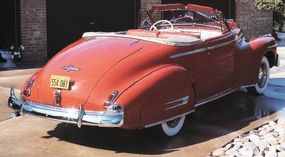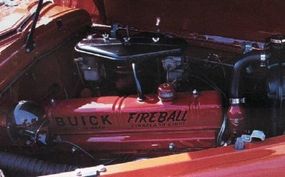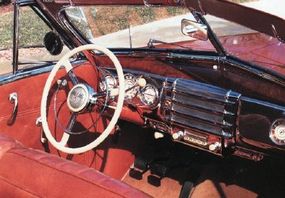In 1941, Buick had its best prewar year, with model-year production at 374,000. One of its best-sellers that year was the Buick Super convertible coupe.
Advertisement
This output was good enough to help Buick continue to hold down fourth place in the industry, where it had been since 1938. Buick's previous best year had been in 1940, and the division built on that success by modernizing its styling for 1941. Headlights were moved out to the edge of the fenders, which themselves were more integrated with the hood. A broader grille accentuated the car's width.
A wide range of prices and sizes were offered. The Special was the volume leader on wheelbases of 118 and 121 inches. The Limited, with a 139-inch wheelbase and plush interior, helped provide the prestige to sell the smaller models. It shared a 320-cid engine with the 128-inch-wheelbase Roadmaster.
In the middle was the Series 50 Super. It combined the 121-inch wheelbase and 248-cube engine of the Special with the body of the larger Roadmaster. Introduced in 1940, the Super was a big success.

Convertibles had much to do with Buick's sales success in 1941. In fact, the make ran second only to Ford in ragtop output. That year's Super lineup included two convertibles: a four-door convertible sedan and the two-door convertible coupe. The latter had a base price of $1,267, but that didn't include the fog lights, bumper end guards, fender skirts, and radio seen on the car featured here.
For the first time on a Buick, a power convertible top was standard equipment, however. A complete set of gauges was set in an attractive Damascened chrome panel, as was the glovebox-mounted clock.

An overhead-valve straight-eight "Fireball" engine powered the car. New for 1941 were high-compression pistons and Compound Carburetion. These changes stampeded horsepower to 125 from the 107 horses of the previous year's Super.
Compound Carburetion consisted of two dual-barrel carburetors. Most of the time only one carburetor was in operation, but under hard acceleration or at high speeds, the second carburetor provided extra power.
Because each of the two carburetors was smaller than the previous single carburetor, gas mileage was claimed to be better in average driving. (Many Buick owners later blocked out the second carburetor hoping to save gas during wartime rationing.)

Access to the engine was easier with a new one-piece hood. The hood could be opened from either side by pulling out the "Louvre-Lock," a hood latch that blended in nicely with the side trim. By pulling both latches, it was possible to remove the hood entirely.
The stiff frame from 1940 was carried over. The independent front suspension's geometry was changed slightly to improve Buick's already comfortable all coil-spring ride. Buick was the first to offer coils at all four corners in 1938.
This 1941 Super convertible coupe, one of 12,391 built, is owned by William Schwanbeck, of Orland Park, Illinois. With the help of some friends, he restored it in 1985.
For more information on cars, see:
- Classic Cars
- Muscle Cars
- Sports Cars
- Consumer Guide New Car Search
- Consumer Guide Used Car Search
Advertisement
